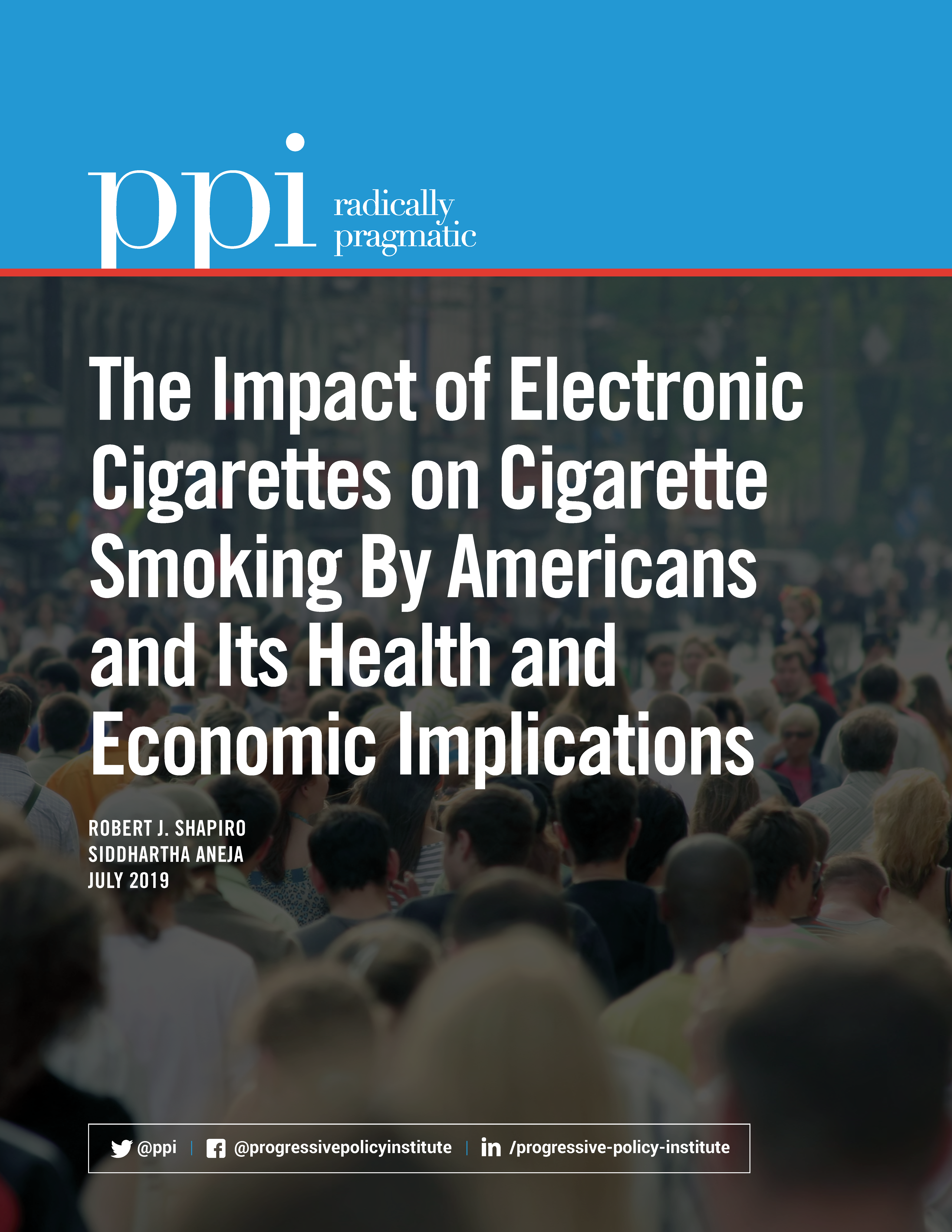The Impact of Electronic Cigarettes on Cigarette Smoking By Americans and Its Health and Economic Implications
By: / 08.01.2019
Download PDFEXECUTIVE SUMMARY
Cigarette smoking by Americans declined steadily from the mid-1960s to around 2005, when this progress began to slow. From 2013 to 2017, however, cigarette smoking rates fell sharply, during a period in which the use of electronic cigarettes or e-cigarettes increased sharply. This study examines the connection between these two developments and the implications.
- Among adults, cigarette smoking rates fell from 18.0% in 2013 to 14.0% in 2017, while the use of e-cigarettes increased from 1.9% to 2.8%.
- Over the same years, cigarette smoking rates among high school students fell from 12.7% to 7.6% while their rates of e-cigarette use increased from 4.5% to 11.7%. Among adolescents, the association between declining smoking rates and rising e-cigarette use was even stronger than among adults.
- Statistical analysis of the changes in smoking rates and e-cigarette use by age, gender, race and ethnicity suggests that about 70 percent of the increased decline in cigarette smoking from 2013 to 2017 was associated with the rising use of e-cigarettes. The remaining 30 percent was associated with higher cigarette taxes, bans on cigarette sales by the CVS pharmacy chain, and increased use of anti-smoking prescription drugs.
- Statistical analysis also strongly suggests that e-cigarettes are not a gateway to smoking cigarettes.
- Rather, statistical analysis and numerous studies establish that e-cigarettes are an effective tool to help people stop smoking or avoid starting to smoke cigarettes.
Based on these analyses, we estimate that pre-existing trends and factors other than e-cigarettes can explain a decline in smoking rates by people ages 18 to 44 from 20.2% in 2014 to 17.9% in 2017. However, the rate fell from 20.2% to 14.6% in 2017, and the rising use of e-cigarettes can explain the additional 3.3 percentage-point decline in cigarette smoking rates.
- By this account, e-cigarette use is closely linked to a reduction in cigarette smoking from 2014 to 2017 by 922,301 people ages 18 to 24 and 2,922,540 people users ages 25 to 44, or a total of 3,844,840 people.
We also calculated the healthcare savings and costs and the productivity benefits associated with the reductions in cigarette smoking and the increased use of e-cigarettes from 2014 to 2017 by those 3,844,840 people ages 18 to 44. These calculations are based on healthcare costs, life expectancy, and the differences in the incidence of illnesses that interfere with work for smokers, ex-smokers, nonsmokers and e-cigarette users.
- E-cigarette use lowers people’s annual per capita healthcare costs, compared to cigarette smokers and ex-smokers, for all age groups up to age 75.
- For people ages 25 to 44, the annual per capita healthcare costs of cigarette smokers are 9.8 percent greater than those of e-cigarette users, and the average annual per capita healthcare costs for ex-smokers are 19.8 percent greater than for e-cigarette users.
- For people ages 45 to 64, annual per capita healthcare spending for cigarette smokers is 8.8 percent greater than for e-cigarette users, and average per capita healthcare costs for ex-smokers are 34.4 percent greater than for e-cigarette users.
- Treating cigarette-smoking-related diseases accounts for an estimated 8.7 percent of annual healthcare spending, or $303.8 billion in 2017.
- By reducing the number of people who smoke cigarettes, e-cigarette use also extends the lifespans of millions of people, raising their lifetime medical costs across all age groups except those 18 to 24.
- We calculate that the use of e-cigarettes by the 922,301 people ages 18 to 24 in 2017, who otherwise would have started smoking cigarettes, should reduce their lifetime healthcare costs by $11.3 billion.
- However, the use of e-cigarettes by the 2,922,540 people ages 25 to 44 in 2017,
who otherwise would have started smoking cigarettes, increases their lifetime healthcare costs by $284.5 billion.
- Those higher lifetime healthcare costs reflect spending for 330,489 people whom we would expect to have died before their mid-to-late 60s if they started smoking cigarettes in 2014- 2017, and for 500,865 people whom we would expect to have died before their mid-to-late 80s if they had started smoking instead of using e-cigarettes.
- E-cigarette users (and nonsmokers) also are more productive than smokers, because smokers miss more work due to illness, come to work still impaired by illness more often, and take smoking breaks. We found that e-cigarette users are on average $820 more productive per-year than ex-cigarette smokers and $2,371 more productive per-year than current smokers, and that ex-smokers who shifted to e-cigarettes are on average $1,554 more productive per-year than current smokers.
- The additional productivity of the share of the 922,301 e-cigarette users ages 18 to 24 in 2017 who worked from 2017 on, and who otherwise would have become smokers in 2014-2017, would be worth $14.7 billion over the 10 years from 2017 to 2027;
- The additional productivity of the share of the 2,922,540 e-cigarette users ages 25 to 44 in 2017 who worked from 2017 on, and who otherwise would have continued to smoke in 2014-2017, would be worth $29.2 billion over the years from 2017 to 2027.
Read the full report.


